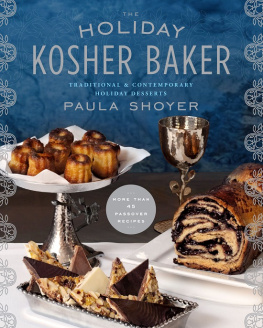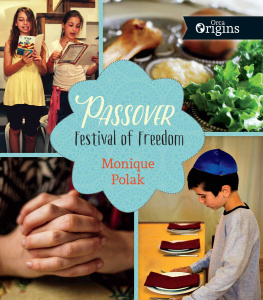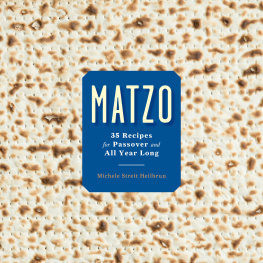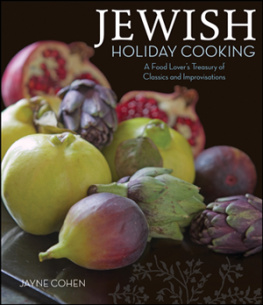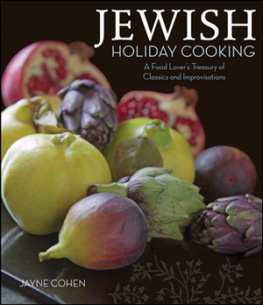Contents

The New
PASSOVER
MENU
PAULA SHOYER
AUTHOR OF THE HOLIDAY KOSHER BAKER


STERLING EPICURE is a trademark of Sterling Publishing Co., Inc.
The distinctive Sterling logo is a registered trademark of Sterling Publishing Co., Inc.
2015 by Paula Shoyer
All rights reserved. No part of this publication may be reproduced, stored in a retrieval system, or transmitted in any form or by any means (including electronic, mechanical, photocopying, recording, or otherwise) without prior written permission from the publisher.
ISBN 978-1-4549-1637-6
Library of Congress Cataloging-in-Publication Data
Shoyer, Paula, author.
The new Passover menu : a fresh look at Passover meals / Paula Shoyer, author of The holiday kosher baker.
pages cm
Summary: Passover is a celebration of freedomand Paula Shoyers innovative Passover collection celebrates culinary freedom, while still honoring the holidays dietary rules. Her dishes will set you free, combining all the nostalgic pleasure of family favorites with 65 contemporary creations sure to please a new generation of creative cooks. Covering both Seder nights and all eight days of the holiday, Shoyer redefines Passover dining with an updated and global menu that includes Banana Charoset, Peruvian Roast Chicken with Salsa Verde, Moroccan Spiced Short Ribs, Sweet Potato Tzimmes, Eggplant Parmesan, and Frittata with Broccoli and Leeks. And dont forget the desserts (many gluten-free) that are Shoyers specialty, including Triple-Chocolate Biscotti, Opera Cake, and Pear Frangipane Tart. To streamline your planning, there are eight full menus to use as is or to mix and match, along with suggestions for other meals. Passover has never been so easy or delicious!Provided by publisher.
Includes bibliographical references and index.
ISBN 978-1-4549-1440-2 (hardback)
1. Passover cooking. I. Title.
TX739.2.P37S56 2015
641.5676437dc23
2014037153
Jacket design by Elizabeth Mihaltse
Jacket photographs by Michael Bennett Kress
For information about custom editions, special sales, and premium and corporate purchases, please contact Sterling Special Sales at 800-805-5489 or specialsales@sterlingpublishing.com.
www.sterlingpublishing.com
Photographs by Michael Bennett Kress
For all the kosher baker fans who asked me to write a cookbook of savory recipes.
But, as my friend Suzin Glickman believes, you should still eat dessert first.
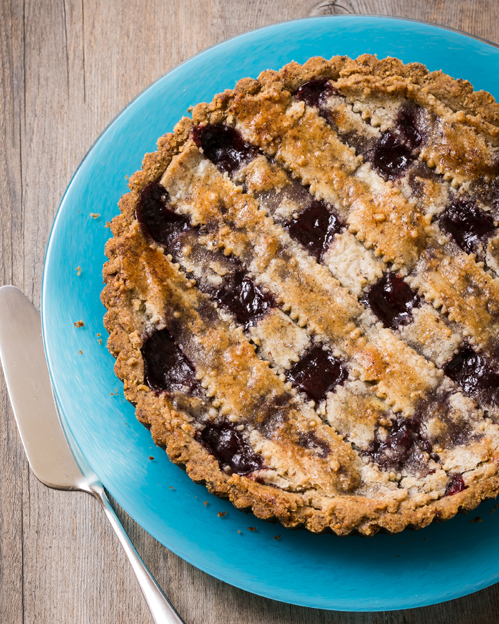
INTRODUCTION
FREEDOM FROM PASSOVER FOOD OPPRESSION
P assover celebrates the Exodus of the Israelites from Egyptian slavery and features the universal theme of triumph over oppression. Elie Wiesel calls Passover the story of hope. During the holiday, we retell the story, perform rituals, and eat foods to reenact the experience of the Israelites. Jews who host the holiday often feel that preparing the house and food for Passover makes them feel a little too much like the Israelite slaves. The New Passover Menu has arrived in order to set you free.
Passover is the central Jewish holiday for entertaining, and families get together for all or part of the eight-day holiday. Passover food evokes many different memories and emotions. Some people recall delicious meals in their mothers or grandmothers homes and recipes that have been passed down through the generations. Others will roll their eyes and lament heavy kugels, dry desserts, and the weight of a holiday that brings many restrictions.
During Passover, Jewish people have to cook and bake within very stringent food restrictions that include no bread, rice, corn, oats, rye, spelt, barley, legumes, and pastaand most people live in areas where there are no kosher-for-Passover restaurants or bakeries. Over the centuries, rabbis have expanded the prohibition against leavened bread to include any food that contains the prohibited ingredients, or which has come in direct contact with them. These foods are considered chametz and are forbidden during the holiday. It is the custom of Sephardic Jews to eat rice and legumes during Passover.
I wanted to write this book because, whenever I travel or tour the world as a kosher baker and cookbook author, people ask me about Passover food and desserts, no matter what time of year it is. Cooking for Passover meals weighs on people. I have always viewed the holidays dietary restrictions as challenges that can be overcome, if you focus on the ingredients that you can use.
The New Passover Menu features updated traditional dishes that provide the nostalgic pleasure of family favorites, along with a raft of contemporary recipes developed to please creative cooks who do not want to compromise their taste for sophisticated recipes during the holiday. Armed with this book and the bonanza of Passover ingredients that are available today, you can enjoy delicious, elegant, and inspired holiday mealsand create new Passover food memories at the same time.

HOW TO USE THIS BOOK
T o streamline your holiday planning, Ive divided the book into eight menus: There are two Seder menus, one menu each for Shabbat and Yom Tov, and four diverse weekday menus. In addition, there is a chapter on breakfast foods and one on desserts that includes fifteen new recipes, most of which are gluten-free. You can follow the menus as they are, or mix and match them as you like. Ive also included an equipment list for each recipe, so youll know which tools you will need, along with preparation and cooking times, and tips to help with meal planning and storage. As I have not accounted for every meal during the eight-day holiday, here are menu suggestions for lunches and other meals:
WEEKDAY LUNCH MENUS
SHABBAT OR HOLIDAY LUNCH MENUS
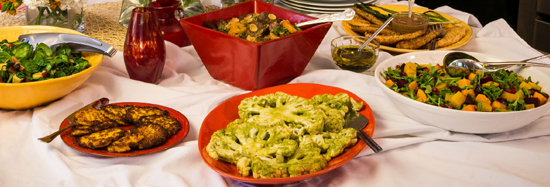
THE PASSOVER PANTRY
A ll processed food consumed during Passover must have the Kosher for Passover designation. There are exceptions, but the list changes from year to year, so you should always check the newest guidelines. All the ingredients I use in this book are available with Passover certification, though you may not find everything where you live. New products hit the market every year, and you can find many Passover ingredients online.
KITNIYOT
The term kitniyot refers to certain grains, legumes, and seeds that are not expressly forbidden on Passover but that Ashkenazic Jews do not eat during the holiday. Examples include rice and corn, lentils, beans, peas, peanuts, and soybeans, and such seeds as amaranth, mustard, sesame, poppy, fennel, cardamom, and sunflower. Ashkenazic Jews do not use these ingredients during Passover for two reasons: The first is that some of them can be made into food that looks like chametz


